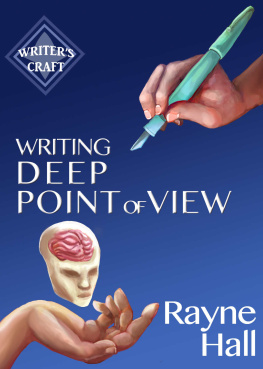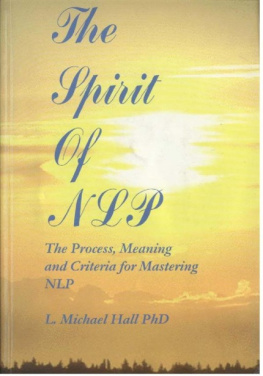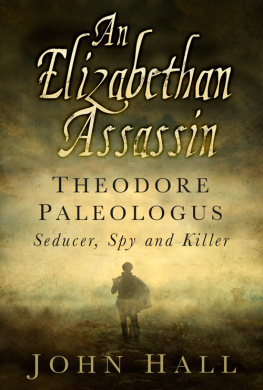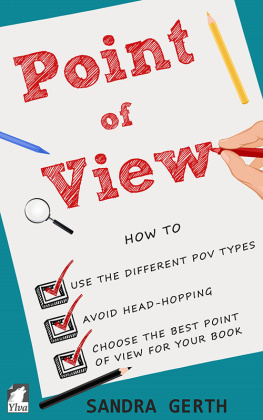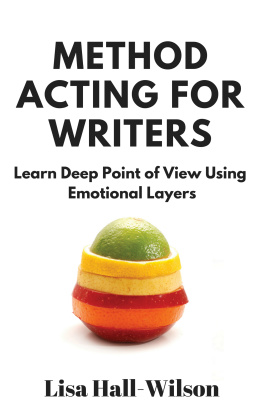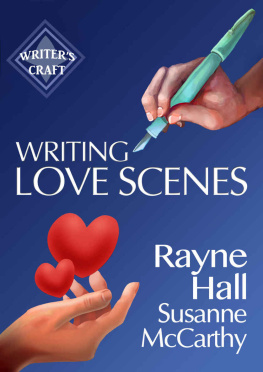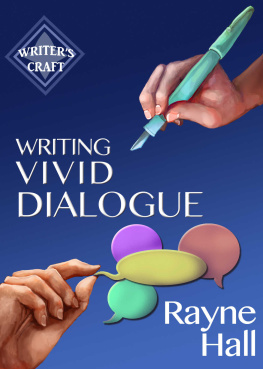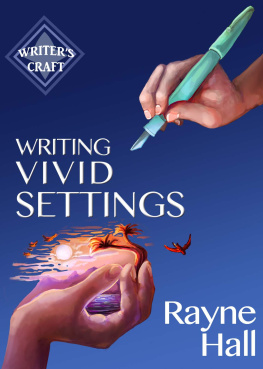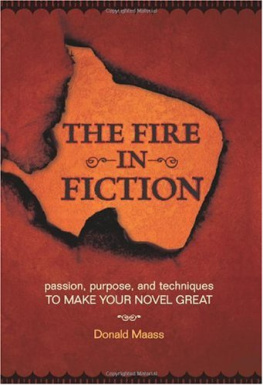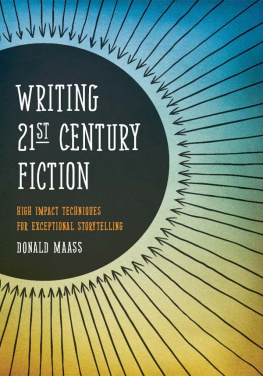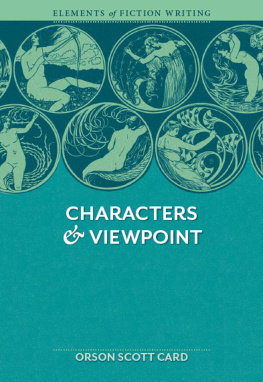WRITING DEEP POINT OF VIEW
by Rayne Hall
WRITING DEEP POINT OF VIEW
by Rayne Hall
Writers Craft Book 13
2015-2019 Rayne Hall
Cover Design by Erica Syverson
August 2019 Edition
ISBN-13: 978-1519231758
ISBN-10: 151923175X
All rights reserved. Do not reproduce in whole or in part without the authors permission.
British English.
TABLE OF CONTENTS
INTRODUCTION
Do you want to give the readers such a vivid experience that they feel the events of the story are real and theyre right there? Do you want them to forget their own world and worries, and live in the main characters head and heart?
The magic wand for achieving this is Deep Point of View.
Deep Point of View is a recent development. Victorian authors didnt know its power. They wrote stories from a god-like perspective, knowing everything, seeing into everyones mind and soul. 20th century writers discovered that when they let the reader into just one persons head, stories became more exciting and real.
If we take this one step further, and delve so deeply into one persons mind that the readers awareness merges with that characters, we have Deep Point of View.
Readers love it, because it gives them the thrill of becoming a different person. The reader doesnt just read a story about a gladiator in the arena, an heiress in a Scottish castle, an explorer in the jungle, a courtesan in Renaissance Veniceshe becomes that gladiator, heiress, explorer, courtesan.
Deep Point of View hooks readers from the start. After perusing the sample, hell click buy now because he simply must read on, and when hes reached the last page, hes grown addicted to the character, doesnt want the story to end, and buys the next book in the series at once.
A reader who has been in the grip of Deep Point of View may find other books dull and shallow. Who wants to read about a pirate, when you can be a pirate yourself? Immersed in Deep PoV, the reader enjoys the full thrills of the adventure from the safety of her armchair.
In this book, Ill reveal the powerful techniques employed by bestselling authors, and Ill show you how to apply them to rivet your readers. Ill start with the basics of Point of Viewif youre already familiar with the concept, you can treat them as a refresherand then guide you to advanced strategies for taking your reader deep.
This is not a beginners book. It assumes that you have mastered the basics of the writers craft and know how to create compelling fictional characters. If you like, you can use this book as a self-study class, approaching each chapter as a lesson and completing the assignments at the end of each session.
To avoid clunky constructions like he or she did this to him or her I use sometimes he and sometimes she. With the exception of Chapter 6, everything I write applies to either gender. I use British English, so my grammar, punctuation, spellings and word choices may differ from what youre used to in American.
Now lets explore how you can lead your readers deep into your story.
Rayne Hall
Chapter 1
FRESH PERSPECTIVES
Instead of explaining Point of View, Ill let you experience it. Lets do a quick practical exercise.
Wherever you are right now, look out of the window (or step out into the open, or do whatever comes closest). If possible, open the window and stick your head out. What do you notice?
Return to your desk or notebook, and jot down two sentences about your spontaneous observations.
You can jot down anythingthe cars rushing by, the rain-heavy clouds drawing up on the horizon, the scent of lilacs, the wasps buzzing around the dumpster, the aeroplane scratching the sky, the empty beer cans in the gutter, the rain-glistening road, whatever. Dont bother writing beautiful proseonly the content matters. And only two sentences.
When youve done thisbut not beforeread on.
*
*
*
Have you written two sentences about what you observed outside the window? Good. Now well have fun.
Imagine that youre a different person. Pick one of these:
- A 19-year-old female student, art major, currently planning to create a series of paintings of townscapes, keenly aware of colours and shapes.
- A professional musician with sharp ears and a keen sense of rhythm.
- An eighty-year-old man with painful arthritic knees which get worse in cold weather. Hes visiting his daughter and disapproves of the place where shes living these days.
- A retired health and safety inspector.
- An architect whose hobby is local history.
- A hobby gardener with a keen sense of smell.
- A security consultant assessing the place where a foreign royal princess is going to walk among the people next week.
Once again, stick your head out of the window. What do you notice this time? Return to your desk and jot down two sentences.
I bet the observations are very different! Each time, you saw, heard and smelled the same placebut the first time you experienced it as yourself (from your Point of View) and the second time, as a fictional character (from that characters PoV).
You may want to repeat this exercise with another character from the list, to deepen your insight and practice the skill. If youre an eager learner, do all seven. This will give you a powerful understanding of how PoV works.
Now lets take it one step further: Imagine youre the main character from the story youre currently writing (or have recently finished). How would he experience this place? What would he notice above all else? Again, write two sentences.
Now youve experienced the power of PoV, this is how you will write all your fiction.
ASSIGNMENT
Repeat this exercise in a different placeperhaps when you have time to kill during a train journey or in the dentists waiting room.
Chapter 2
WHOSE POINT OF VIEW?
In this chapter, we choose the character whose experience the readers get to share.
CHOOSING THE CHARACTER
Deep PoV stories are best told completely through the eyes of one person who experiences it all. Decide from whose perspective you want to tell the story.
This is probably the main character (MC), the person who has most at stake and takes action to achieve the story goalthe detective hunting the serial killer, the adventurer on a quest to find the magic jewel that will save the land, the governess seeking true love.
Some stories can be told from the PoV of an observer, like Dr. Watson watching Sherlock Holmess actions. This can be an effective technique, but only if you dont want to rouse the readers emotions.
Pick a character who is present at all story events, at least during the critical scenes.
If a story needs several perspectives, you can switch from one PoV to another, for example, the PoV in a Romance novel may alternate between the heroine and the hero, a Thriller may intersperse the investigators PoV with glimpses inside the serial killers mind, and when the first PoV of your Historical novel dies on the battlefield, his son may take up his PoV as well as his sword.
If you choose multiple perspective, keep to one PoV at a time, then change. Later in this book Ill show you how you can make the switch and still keep most of the depth. However, the readers emotional involvement is greatest if she stays inside the same persons mind.
FIRST, SECOND AND THIRD PERSON
The next decision is whether to write in First, Second or Third Person. This will affect your storys voice and style.
First Person: I grabbed my bag.
Second Person: You grabbed your bag.
Third Person: She grabbed her bag. Or: He grabbed his bag.
All possible and valid options.
Third Person
Third Person gives you most flexibility, especially if you plan to use more than one PoV. It suits almost every story and genre, so if in doubt, opt for this one. The only drawbacks are stylistic: you may get a lot of pronouns (he/she/him/her/his/hers), and in scenes with several people of the same gender, it can get confusing who the he is.
Next page
